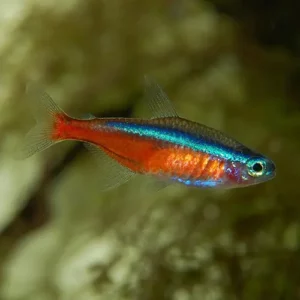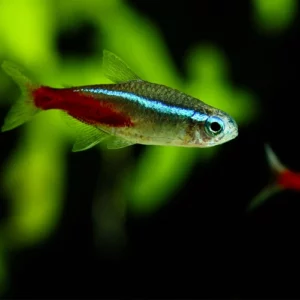Can Neon Tetra Live With Angelfish? Sometimes And How
Neon Tetras can potentially live with Angelfish under specific conditions. While Neon Tetras are small, peaceful schooling fish, Angelfish possess a semi-aggressive nature, especially as they mature, posing a risk to smaller fish. Both species have overlapping environmental needs, such as water temperature and pH, which can facilitate compatibility. Young Angelfish, being less predatory, are more adaptable to sharing a tank with Neon Tetras. However, as Angelfish grow and especially during breeding, their predatory instincts may intensify. To foster harmony, spacious tanks, dense vegetation, and strategic introductions are recommended. Observing behavior, using tank dividers for initial interactions, and always having a backup plan are essential for the well-being of both species.
Home » Guides » Fish Care » Neon Tetra » Can Neon Tetra Live With Angelfish? Sometimes And How
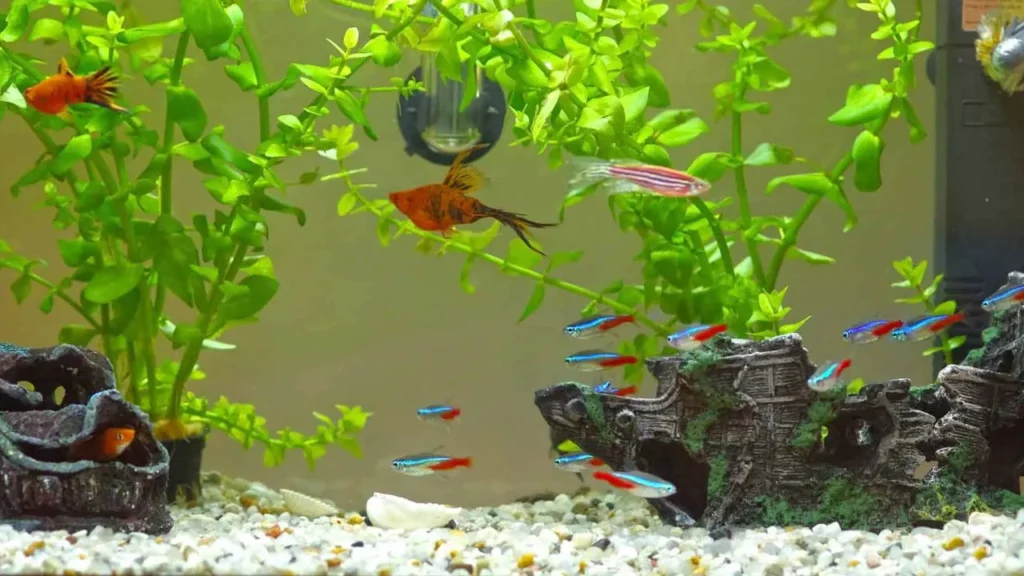
Neon Tetra Fact Sheet
| Scientific Name | Paracheirodon innesi |
| Common Name | Neon Tetra, Neons |
| Care Difficulty | Easy |
| Life Expectancy | 3-10 Years |
| Average Size | 1.5 Inches (3.8cm) |
| Temperature | 72°F – 82°F (22°C -28°C) |
| Diet | Omnivore |
| Behavior | Friendly/Peaceful |
| Breeding | Medium/Hard |
| pH | 6-7.5 |
| Live Plant Friendly | Yes |
Basic Nature of Neon Tetra and Angelfish
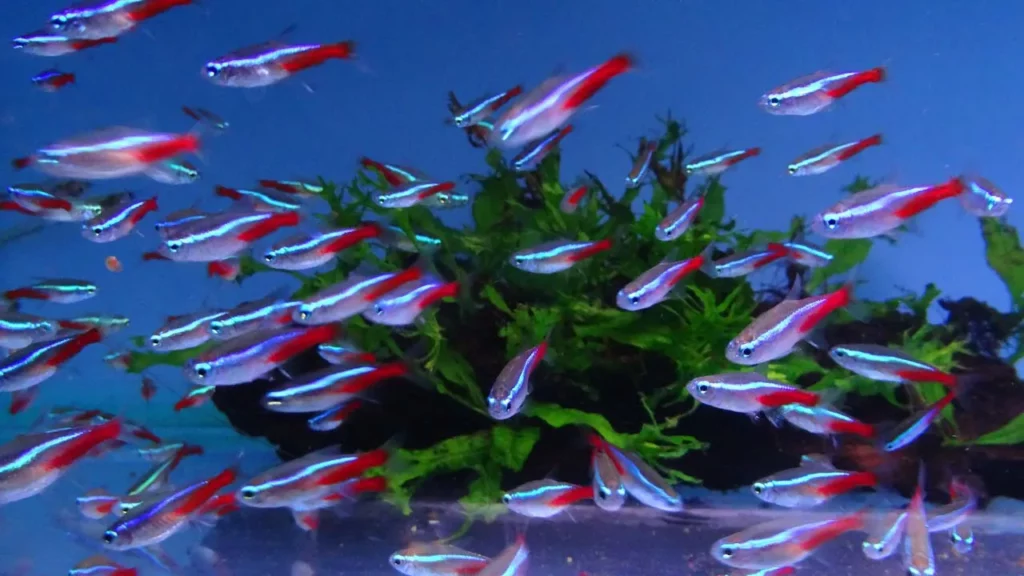
Neon Tetras
Size and Appearance: The diminutive Neon Tetra, typically reaching just 1.5 inches in adulthood, often captures hearts with its luminous blue stripe running along its body, perfectly complemented by a shimmering red stripe just below. Their small size might make them appear fragile, but with proper care, these little swimmers are quite resilient.
Schooling Nature: One cannot truly appreciate Neon Tetras unless they witness them in a school. These social fish thrive in groups, ideally six or more. In their natural habitats, they swim together in harmonious synchrony, which is not only a survival tactic against predators but also a mesmerizing aquatic ballet for those fortunate enough to observe. In an aquarium, their schooling behavior is both a pleasure to behold and a key to their wellbeing.
Peaceful Behavior: Despite what their electric appearance might suggest, Neon Tetras are one of the most peace-loving inhabitants you can introduce to your tank. They rarely exhibit aggression, especially when kept in adequate numbers. But remember those keywords, “Are Ember Tetras aggressive?” or “Aggressive Ember Tetra?” – Interestingly, Ember Tetras, another darling of the Tetra family, share a similar peaceful disposition with their Neon counterparts.
Angelfish
Size and Appearance: Starting life as tiny, delicate fry, Angelfish grow, and they grow impressively! Reaching up to 6 inches in length and even taller in height (thanks to those splendid dorsal and anal fins), they’re a sight to behold. Their unique body shape, combined with the array of available patterns and colors, from shimmering silvers to stripes and marbles, has endeared them to aquarists for generations.
Semi-Aggressive Behavior: Beneath their royal facade, Angelfish possess a semi-aggressive nature, especially as they mature. While they often coexist peacefully with various tank mates, their predatory instincts can come to the fore, especially when they see smaller fish flitting about. It’s this juxtaposition of beauty and beast that makes the Angelfish both enchanting and a bit enigmatic.
Predatory Instincts: Those who have cared for Angelfish can attest to the shift in behavior as these fish grow. Juveniles, curious and playful, tend to be more accepting of their tank mates. However, as adults, their inner predator awakens. Those smaller fish, especially ones with slender bodies like Neon Tetras, can be perceived as potential prey. It’s nature’s way, but it’s a trait aquarists need to keep in mind.
Why There’s Potential for Compatibility
Similar Environmental Requirements
Mother Nature, in all her wisdom, often sprinkles her creations with shared habitats and needs. This is especially evident when we peek into the world of Neon Tetras and Angelfish. While their personalities might differ, their environmental preferences have a lot in common, providing a foundation for potential harmony.
Temperature: Both Neon Tetras and Angelfish hail from the warm waters of South America, particularly the Amazon basin. This shared origin means they both prefer a water temperature between 74°F to 80°F. By maintaining a steady temperature within this range, both species can comfortably thrive.
pH Levels: Freshwater aquarium enthusiasts would understand the importance of pH – the measure of acidity or alkalinity. Neon Tetras and Angelfish prefer slightly acidic to neutral water. A pH value of around 6.0 to 7.5 is their sweet spot. So, if your aquarium has a pH within this range, both these fish will feel right at home.
Water Hardness: Both these species have evolved in soft water environments. Thus, a water hardness level of soft to moderately hard (around 1 to 12 dGH) is ideal for their health and well-being.
While the similarities in environmental needs offer a glimmer of hope for cohabitation, it’s essential to remember that maintaining stable water parameters is crucial. Fluctuations, especially rapid ones, can stress both species, potentially leading to health issues or, even worse, the triggering of the “Ember Tetra aggressive” behavior (for those considering Ember Tetras as an additional tankmate).
Peaceful Juvenile Angelfish
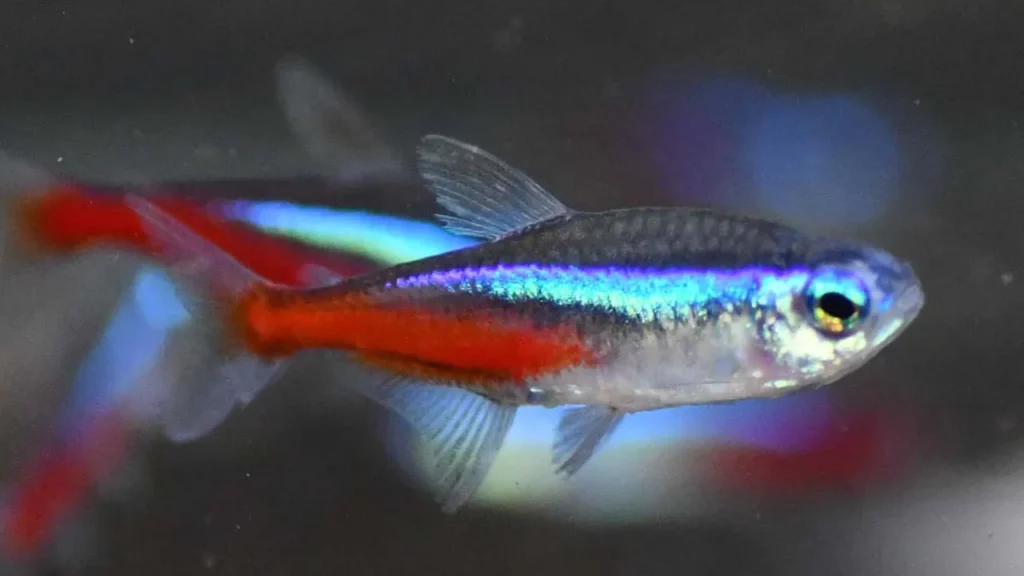
Childhood, even in the fish world, is a time of innocence and exploration. Just as human youngsters are more accepting and adaptable, juvenile Angelfish are often more docile and less set in their ways compared to their adult counterparts.
The Younger Days: Juvenile Angelfish are more focused on exploration and understanding their environment than asserting dominance or hunting. Their smaller size and developing instincts mean they’re less inclined to view other fish as potential meals. Neon Tetras, darting about in their school formations, are typically safe around these younger Angelfish.
Growing Up Together: One of the endearing aspects of young Angelfish is their ability to form bonds or at least habits of coexistence when introduced to an aquarium environment with other species at a young age. If Neon Tetras and juvenile Angelfish grow up together, they’re more likely to recognize each other as parts of the same community rather than adversaries or prey.
It’s Not Forever: Alas, as with many things in life, this period of relative peace doesn’t last forever. As juvenile Angelfish mature, their inherent predatory instincts become more pronounced. This transition phase is vital for aquarists to observe and be prepared for. Nonetheless, the early days can set a precedent for relatively peaceful interactions.
Challenges in Keeping Neon Tetra and Angelfish Together
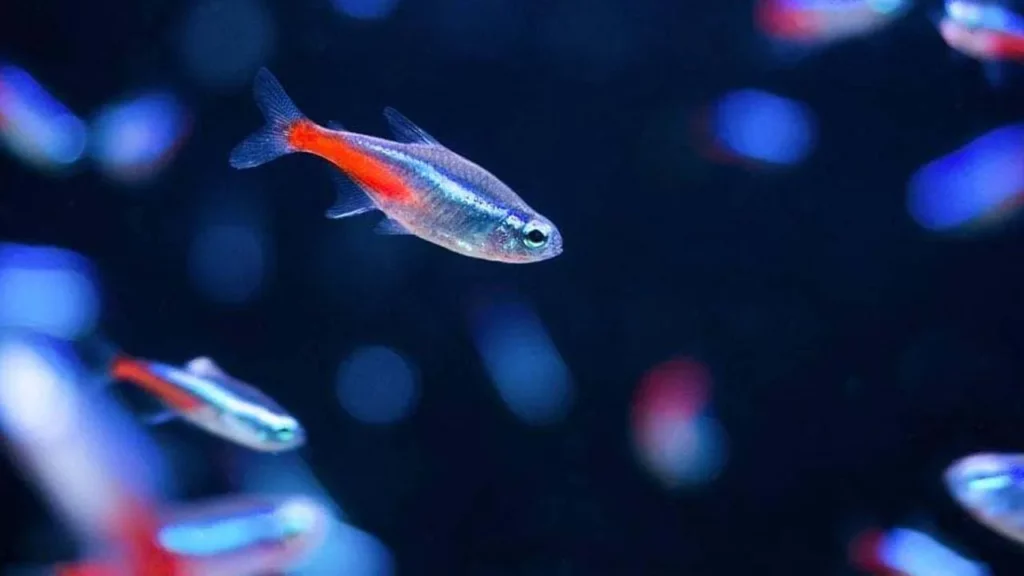
Predatory Nature of Adult Angelfish
As the seasons of life progress, and our juvenile Angelfish morph into their mature selves, a change begins to ripple through our tranquil aquarium. That small, curious Angelfish, which once swam alongside Neon Tetras without a second thought, starts to show a side of itself that’s more primal and, for our Neons, quite concerning.
The Call of the Wild: Angelfish, in their essence, are cichlids, a group known for its diverse range of behavior, including predatory tendencies. As adults, they become more aware of their surroundings, and their size allows them to see smaller fish, like our glowing Neon Tetras, as potential snacks. It’s not personal; it’s just nature.
Observing Behavior: Aquarists might start to notice the Angelfish closely following or cornering Neon Tetras. This behavior isn’t them trying to make friends. It’s a manifestation of their hunting instinct. It’s crucial to monitor this behavior closely, as it can quickly escalate from mere curiosity to an actual hunt.
Size Matters: The size difference between adult Angelfish and Neon Tetras isn’t just for show. A fully grown Angelfish has a mouth large enough to swallow a Neon Tetra whole. While the thought is grim, it’s a reality one must prepare for when housing these two species together.
Not All Angelfish Are Alike: Just as humans have diverse personalities, so do Angelfish. Some might remain relatively peaceful, showing little interest in their smaller tank mates, while others might revel in their role as the apex predator of the tank.
Stress and Vulnerability
In the vast mosaic of aquatic life, stress is a silent yet potent enemy. Just as we humans find it taxing to be constantly on edge, fish, especially those as delicate as the Neon Tetra, suffer immensely when under continual threat. The towering presence of a predatory Angelfish can be more than just a fleeting concern for these little glimmers of light.
Constant Vigilance: Imagine having to always watch over your shoulder, anticipating a potential chase or confrontation. Neon Tetras, when feeling threatened, can be in a state of perpetual alertness. Such a life is neither comfortable nor healthy for these gentle beings.
Physical Ramifications: Stress, if prolonged, doesn’t just affect the emotional state of the Neon Tetras but can manifest physically. A stressed fish may exhibit loss of color, reduced appetite, lethargy, and in some unfortunate cases, even fin rot or other diseases. Their shimmering hues might dim, and their lively school dances may become sporadic and less synchronized.
Weakened Immunity: Just as stress weakens the human immune system, it does the same to fish. A constantly threatened Neon Tetra is more susceptible to infections, parasites, and other ailments. This vulnerability can lead to a domino effect, with one sick fish potentially affecting the health of others in the aquarium.
Mental Strain: Fish, though different from us in many ways, still have feelings, perceptions, and awareness. The emotional toll of living in constant fear can lead to changes in behavior, like hiding for extended periods, erratic swimming, or even self-inflicting harm.
Harmony in the aquarium isn’t just about preventing physical altercations; it’s also about ensuring mental and emotional well-being for all its inhabitants. A stressed Neon Tetra isn’t just a potential victim of predation but a being that suffers silently in its shimmering corner. As stewards of their aquatic realms, aquarists should aim not just for coexistence but for genuine peace and understanding among all tank inhabitants.
Territorial Behavior during Breeding
Even in our serene aquariums, romance and territoriality often go hand in hand. Especially when Angelfish, those regal beings of the aquatic realm, decide it’s time to start a family. However, this natural process can lead to challenges for our delicate Neon Tetras.
The Nesting Instinct: When Angelfish are ready to breed, they exhibit heightened territorial behaviors. They select a site, often a broad leaf or a flat surface, and zealously guard it. This behavior isn’t them merely being cantankerous; they’re instinctively protecting their future offspring.
Increased Aggression: While Angelfish may show signs of aggression as they mature, this behavior often peaks during breeding. They aren’t just chasing off potential threats but any creature that ventures too close to their chosen nesting site. Unfortunately, our inquisitive Neon Tetras, always darting about, can inadvertently become targets of these protective parents.
Space Invasion: Angelfish, during breeding, expand their “personal space.” This can make a previously safe corner of the tank a sudden no-go zone for other fish. Neon Tetras, unaware of this new boundary, may accidentally wander into these territories, leading to swift and often aggressive responses from the breeding Angelfish.
Temporary Change: It’s worth noting that this heightened territorial behavior is usually temporary, lasting primarily during the breeding and early fry-rearing phase. However, given how stressed the other tank inhabitants can get during this period, it might seem like an eternity to them.
Love, protection, and territoriality – a potent mix in any environment! For our Neon Tetras, the breeding rituals of the Angelfish can be akin to navigating a minefield. They must be ever-vigilant, treading carefully amidst the blossoming love saga of the Angelfish. Aquarists, with their keen eyes and compassionate hearts, need to be ready to intervene if this dance of love becomes too overwhelming for their aquatic charges.
Recommendations for a Sometimes Peaceful Coexistence
Spacious Tanks
Water, that life-giving element, isn’t just about quenching thirst or filling a bowl. In our aquarium world, space is more than just water—it’s the universe in which our aquatic buddies breathe, dance, and express themselves. One of the primary ways to ensure that the Neon Tetras and Angelfish coexist peacefully is to provide them with ample space.
Freedom to Roam: Just as we humans love a spacious home, fish, too, relish their freedom to swim, explore, and establish territories. A larger tank offers more real estate for both species, ensuring that they aren’t always swimming atop one another or constantly invading each other’s personal spaces.
Reduced Stress: Remember our stressed Neon Tetra from earlier? A spacious environment can significantly reduce its anxiety. Having the room to move about freely, away from potential threats, means less stress and a healthier life.
Territories and Boundaries: Angelfish, especially during breeding, can become territorial. A spacious tank allows them to establish and guard their territories without causing too much disruption to the rest of the tank inhabitants.
Size Recommendations: For an aquarium housing both Neon Tetras and Angelfish, I’d recommend a minimum tank size of 40 gallons. However, if you can go larger, by all means, do! It’s an investment not just in the aesthetics of your space but in the well-being of your finned friends.
Dense Plantation and Hideouts
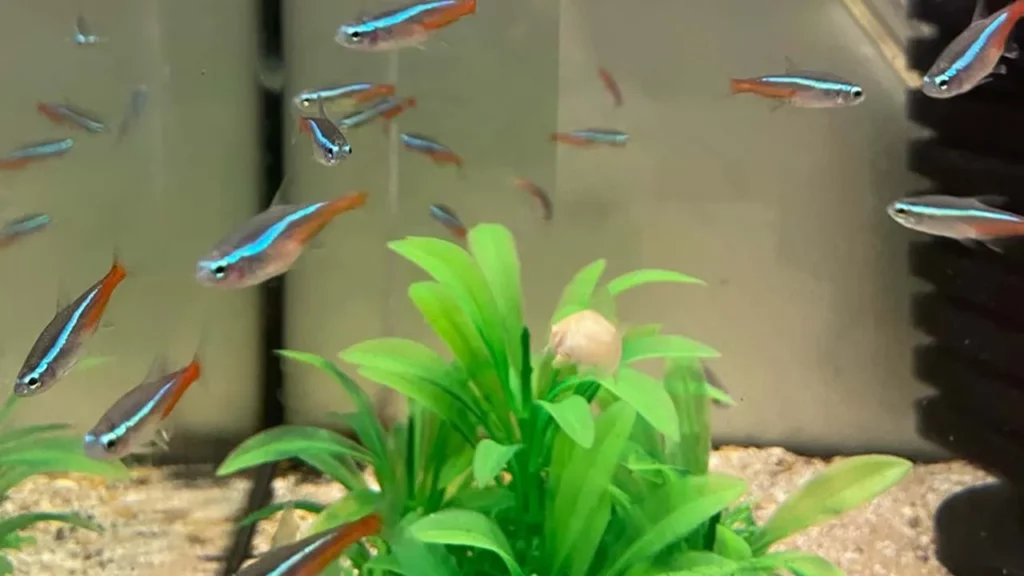
Ensuring ample hiding spots and vegetation for neon tetras to seek refuge
Nature, in her infinite wisdom, has provided us with lush forests, thickets, and cozy caves as refuges against potential threats. In our scaled-down aquatic universes, the role of dense plantations and hideouts becomes paramount, especially when aiming for peaceful coexistence between species like Neon Tetras and Angelfish.
Natural Barriers: Dense plants in an aquarium act as natural barriers, breaking lines of sight. This is particularly helpful in diffusing potential aggression. If an Angelfish can’t constantly see or chase a Neon Tetra because there’s a thicket of plants in the way, the likelihood of aggressive interactions reduces.
Stress Reduction: Remember our discussions on stress in Neon Tetras? Well, dense plantations can act as a calming sanctuary. Being able to weave through the aquatic greenery or hide amidst the foliage provides these little fish with a sense of security.
Breeding Boundaries: Plants can also serve as natural boundary markers. During their breeding episodes, Angelfish might claim certain plant-dense areas as their territories. While this does mean Neon Tetras will need to steer clear, the dense plants provide a clear visual cue of where these territories lie.
Hideouts and Caves: Apart from plants, integrating hideouts like caves, driftwood with nooks, or specially designed hiding spots can be beneficial. These act as retreats during times of heightened aggression or stress, especially for the smaller Neon Tetras.
Selecting the Right Plants: Opting for plants like Java Fern, Anubias, and Cryptocoryne can be great. They are hardy, can grow dense enough to provide cover, and generally tolerate a range of water conditions. Floating plants like Water Lettuce or Duckweed can also be a great addition, offering refuge from above and breaking direct lines of sight.
Picture this: A densely planted aquatic Eden, where light filters through layers of leaves, creating dancing shadows and myriad hiding spots. Neon Tetras flit through the underbrush, and Angelfish patrol the open areas, their territories clearly marked by thickets and caves. Such an environment doesn’t just promote coexistence; it sings a song of nature, balance, and harmony.
Introduce Neon Tetras as a School
The Power of the Collective: A lone Neon Tetra is like a solo dancer on a vast stage – vulnerable and exposed. However, in a school, these tiny tetras create a formidable presence. Their combined movement can be mesmerizing and serves a functional purpose: it deters larger fish like the Angelfish from targeting individual members.
Diffusion of Aggression: When presented with a group, an Angelfish is less likely to single out one Neon Tetra for a chase or an attack. The unified movement of the school can confuse or overwhelm potential predators.
Emotional Well-being: Beyond mere survival, schooling plays a vital role in the emotional well-being of Neon Tetras. They feel more secure, less stressed, and their natural behaviors come to the fore when they’re in a group. A solo Neon Tetra might hide and shy away, but in a school, they exhibit their characteristic vibrancy and zest for life.
How Many Make a School? For a harmonious aquarium with Angelfish, introducing a school of at least 10-15 Neon Tetras is advisable. Not only does this ensure their safety in numbers, but it also promises a visual spectacle for the aquarist and any onlookers.
Monitor and Choose Angelfish Temperament
Observation is Key: Before introducing Neon Tetras, spend time observing potential Angelfish candidates. Watch for signs of undue aggression, such as constant chasing or fin nipping. An overly aggressive Angelfish is likely to view Neon Tetras not as tank mates but as a delightful, darting snack.
History Matters: If possible, gather information on the Angelfish’s past living conditions. An Angelfish that has been raised with smaller fish and has a track record of peaceful cohabitation is a more promising candidate than one with no such history.
Compatibility Tests: Some fish stores offer compatibility tests, where Angelfish are placed in a tank with smaller fish to monitor their reactions. This can give valuable insights into the Angelfish’s temperament.
Evolution of Behavior: It’s essential to remember that fish, like all living beings, can change over time. A young, peaceful Angelfish might become more territorial as it matures. Hence, regular monitoring and being ready to make necessary adjustments is crucial.
Consider the Individual: While Angelfish are generally semi-aggressive, there are always exceptions. There might be individual fish that are more docile and well-suited for community tanks. Trust your instincts and be patient in your search.
Introduction and Acclimation Strategies
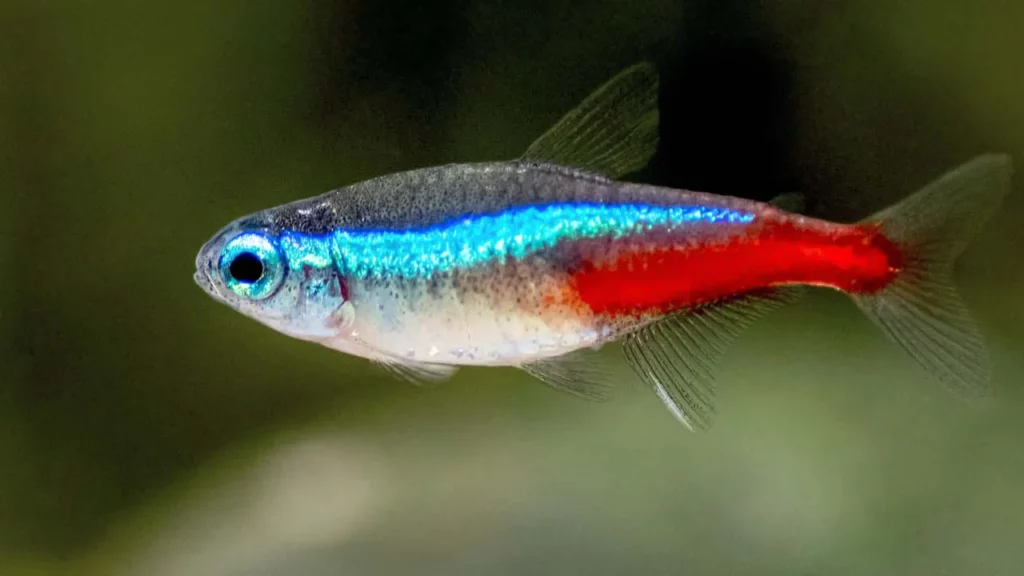
Adaptability: Young Angelfish are still discovering their environment and understanding their place in the watery hierarchy. This makes them more adaptable to the presence of other fish, including the swift and gleaming Neon Tetras.
Reduced Predatory Instincts: While the predatory nature is intrinsic to Angelfish, in their juvenile phase, this instinct isn’t as pronounced. Their smaller size means they’re less likely to view Neon Tetras as potential meals.
Nurturing Cohabitation: Introducing Angelfish and Neon Tetras together at a young age allows them to grow up together, forming a sense of community. This shared history can lead to a more harmonious relationship in their adult phase.
Observation and Adjustment: While introducing young Angelfish can provide a head start, it doesn’t guarantee perpetual peace. As they grow, their behavior might evolve. Regular observation and a readiness to adjust are critical.
Size Considerations: Even though young, remember that Angelfish will grow. Ensure the tank size and environment can accommodate them as they transition from curious juveniles to majestic adults.
Use a Tank Divider Initially
The concept of boundaries isn’t foreign to our human experience. Just as we sometimes need our personal spaces, our underwater friends can benefit from clear, defined territories, at least in the initial phases of their introduction. Enter the role of the tank divider.
Purpose of the Divider: A tank divider is a non-permanent barrier that splits the aquarium into separate sections. It ensures that fish on either side can see each other, get accustomed to each other’s presence, but not physically interact. Think of it as a “get-to-know-each-other” phase without the risks of direct confrontation.
Safety First: The primary purpose of introducing a tank divider is safety. Especially when dealing with potentially aggressive interactions between Angelfish and Neon Tetras, a divider ensures that neither party can harm the other.
Monitoring Interactions: With a divider in place, it becomes easier to observe the behavior of both the Angelfish and the Neon Tetras. Are the Angelfish constantly flaring their fins and showing signs of aggression? Or are they relatively calm, showing more curiosity than hostility? These observations can guide the next steps in their cohabitation journey.
Phased Integration: After a period of separation with a divider, and if observations indicate reduced aggression, the divider can be removed, allowing for direct interactions. This phased approach helps ease both species into sharing their environment.
Additional Benefits: Tank dividers can also help reduce stress for the Neon Tetras. Seeing their larger neighbors without the immediate threat of confrontation can help these small fish adjust better when the divider is eventually removed.
Always Have a Backup Plan
Prepare for the Unexpected: No matter how meticulously we plan, observe, and implement strategies, the world of fish, like ours, is teeming with individual personalities and unexpected turns. Just as we keep an umbrella handy for a sudden downpour, having a backup plan for our aquatic friends ensures their safety and well-being.
Alternative Setup: If aggressive behavior emerges despite all precautions, it’s essential to have another tank or a separate holding area ready. This ensures that any stressed or threatened fish can be swiftly moved to a safer environment, allowing them to recuperate.
Seek Expert Advice: While it’s wonderful to rely on personal observations and instincts, there’s immense value in seeking counsel from fellow aquarists or experts in the field. They can provide insights, share their experiences, and offer alternative solutions.
Flexible Mindset: It’s a humbling reminder, dear aquarist, that we are but facilitators in this grand underwater tapestry. Sometimes, nature has its own designs, and our role is to adapt, adjust, and accommodate. Being mentally prepared for changes ensures we make the best decisions for our finned friends.
Remember the Goal: The endgame is always the well-being and happiness of our aquatic companions. If cohabitation doesn’t seem viable, it’s okay. What’s essential is ensuring a safe, stress-free environment for all the inhabitants of our aquatic realms.
Frequently Asked Questions – FAQ
Give Us Feedback
Please help us get better by making suggestions or giving feedback, we really do listen to it!

